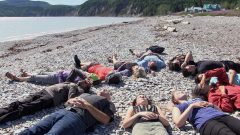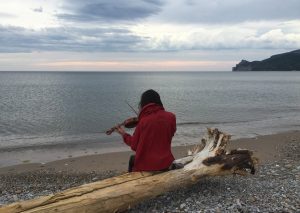 Deep Listening at the End of the World
Deep Listening at the End of the World
By Jeannette Hicks
I’m sitting beside the ocean at the end of the world singing with a wave. A rhythmic low whoosh, and a building sigh–
hhhhhwAAAAAAaaaannsss
ssshhaaaaaaaaAAAAAAAnnng…….
Around me, perched on pebbles and driftwood, are musicians here as part of Musical Improvisation at Land’s End / Coin-du-Banc en folie!—a bilingual improvised music camp taking place this week in the small coastal town of Coin-du-Banc, Québec. We’re taking part in a deep listening exercise facilitated by vocalist Kathy Kennedy, reinforcing sounds around us—whooshing waves, rocks skittering as people walk past, the high squee! of a bird, groans and wails from other human voices.
Deep listening is a musical practice developed by musician and composer Pauline Oliveros for generating increased attention to sound. But, as becomes clear during the course of the week, it’s also an interpersonal ethos—a way of being together in community.
Sound and Noise
“Wherever we are, what we hear is mostly noise.When we ignore it, it disturbs us. When we listen to it, we find it fascinating…”(John Cage, Silence, 3)
By the second day something strange begins to happen. A low tone appears underneath the whir of the fan in my room, and then a high tone. Droplets of water in the bathtub plonk out anatonal melody. As the threshold between signal and noise starts to shift, everything is becoming music…
Not only that, but the space around us is somehow becoming thicker. As percussionist Jesse Stewart tells us, “the primary responsibility of the improviser is to evaluate context.”Here we don’t all speak the same language, play the same instrument, or have the same level of musical experience. Many of us speak mostly French, while others speak mostly English. Some of us come from big cities, while others come from small communities nearby. Some are experiencing the first joys of making music, while others play regular gigs across the country.
I’m not a musician or a native French speaker. As a research assistant with the International Institute for Critical Studies in Improvisation (IICSI) at the University of Guelph, I’m here to interview participants for a documentary, to listen and facilitate.But dialogue across difference is itself an improvisation. And so, as I get to know the participants and share their experiences, I find myself thinking about the social dynamics of improvisation more and more. This is what I’ve learned from being among improvising musicians.
Attunement
In the silence before playing, sounds from the land around us form the orchestral hum. Attuning ourselves to them and to each other, we try to become fully present…
Improvisation suspends the hierarchical relation between composer and performer, conductor and orchestra. In this way, it creates a unique creative space in which artists can relate to one another as equals. In this space, the pressure to be “special” in some way loosens its grip, and people become less guarded and more open. And more vulnerable.
Any venture into the unknown involves risk—just ask those who brave sea, storm, and the occasional lobster claw to catch their dinner not far from here. In improvisation it’s the risk of failure that people fear, of making a fool of oneself, of playing the “wrong” note.
It’s hard to be that vulnerable without compassion—compassion for others as they venture out into the unknown, and compassion for ourselves as we try something new. Improvisation requires trust that we can be vulnerable together without having to hide behind virtuosity, skill, or feigned indifference, retreating back to the solid ground of what we think we already know.
As Pauline Oliveros says “compassion (spiritual development) and understanding comes from listening impartially to the whole space/time continuum of sound” (Deep Listening, xxv).When there are no wrong notes, it’s also not about getting it “right.” In improvisation, it’s not about corresponding to an external standard, but about building something new together, adding what’s appropriate within the context of the unfolding music, and staying emotionally present.
Likewise, communicating across linguistic difference requires shifting the emphasis away from achieving “perfect” linguistic performance and towards compassionate listening. We can never be ready enough, or perfect enough. But we can be present.
Deep listening, as a compassionate listening skill developed in improvisation, fosters a distinctive environment of mutual respect across difference that extends beyond the moments of musical performance. Slowly, over the course of the week, a shift begins to happen in our conversations. Whenever possible, we start switching into the language that’s most comfortable for the hearer—even if not for the speaker. Even those who know only a few words in the other language are piecing them together and offering them up. Where there is compassion and trust, it becomes possible to take new risks, and make a real human connection across difference.
With such compassion, uncertainty can feel playful and freeing rather than terrifying. Being here feels “nurturing but free” one participant comments a few days in.And it’s true. Off to our right rocky bluffs curl around the bay protectively blunting the force of the ocean. And here, we’re starting to reconnect with the raw joy of making a sound—a tap with a rock, a thunk on some driftwood, that first satisfying squawk on the clarinet…
Structure and Freedom
Yet even while we venture out into the unknown, we can’t unhear everything we’ve ever heard and make a sound in a vacuum. As Cornelius Cardew once lamented, even when we try to create something new, our experience is stretched on the frame of our musical memories (“Towards an Ethic of Improvisation,” xix).The cultural ideas that shape what intuitively sounds good to us are always in play, even while we explore their boundaries and push against their edges. We cannot entirely step outside of their “meaning-making space” (Houle, Responsibility, Complexity and Abortion, 29).
But maybe we can displace it.
Structure is not only limiting—something imposed from outside that squelches creative freedom. It is also productive. It’s the theme to our variation. It’s the space in which it resonates.
Cultural assumptions form the space of intelligibility that divide sense from nonsense, audible from inaudible. Experience is shaped by what the philosopher Jacques Rancière has called the “distribution of the sensible” [le partage du sensible]—a set of mutable tacit norms that allow the sensory and conceptual world to be carved up into meaningful pieces and shared in common (Rancière, The Politics of Aesthetics, 12-13).[2]It is this within this sensorium that the new can come into being and be heard or thought
—or not.
Despite the egalitarian ethos of improvisation, in any human interaction there are relations of power. Some instruments make more sound than others. When some people speak, many people listen, while others find it very difficult to be heard at all. Here, at the site of some the first encounters between Indigenous people, French and English settlers and newcomers to Canada, this is especially evident. Which language we speak is political. Who is a part of the conversation and who is not is political. The push and pull of power happens in everyday interactions between people.
Redistributing the Sensible
As Alissa Firth-Eagland has commented on a recent essay published on this site, working co-intentionally and co-creatively is essential to avoiding the reproduction of dominant relations of power (“All We Have is Each Other”).[3]Improvisation offers an important model of co-intentional co-creation in which we all design and bring into being the forms of collective life together.Through the collective action of many people, a new form can emerge—a musical piece, a conversation, or a way of living together.
Living together in community is itself an improvisation. One village over, in l’Anse-à-Beaufils, a group of residents banded together to save the crumbling fish factory that had once been the mainstay of the community. La Vieille Usine de l’Anse-à-Beaufils today is a community arts hub that houses a concert hall, a recording studio, an art gallery, and a restaurant. In a painting on the wall of the recording studio, a giant fish carries an entire village on its back. Like that fish, this gathering place now supports the collective life of this village. It’s a success story of arts-based community making.
But it’s also an example of collective improvisation. Improvisation generates new forms that are not the result of any one person’s idea imposed on the rest through hierarchy or influence, but that emerge as the result of collective action.
Nonetheless, seeking a new sound together is not about synthesizing dissonance into consonance, or disagreement into consensus. For improvisation to be genuinely co-intentional, we need to be able to hear each other, even, and especially, when we disagree. Without a space for disagreement, consensus could easily conceal coercion and silently reproduce dominant relations of power.
Deep listening can help to mitigate the influence of differentials of power by loosening the hold of familiar patterns of thought and sensation, making possible real dialogue across difference.The Deep Listening Institute has developed a musical instrument that translates movement into sound, making it possible for everyone to make music, no matter the nature or extent of their range of movement. The Adaptive Use Musical Instrument (AUMI)[4] empowers people to make music who might not have otherwise been able to do so. It also widens the sphere of musical possibility by opening creative dimensions that may have never been explored without the unique contributions of previously excluded people.
By shifting the threshold of meaning that separates sound from noise, deep listening not only makes it possible to hear sounds that were formerly inaudible, but to improvise new sounds, and new patterns of audibility as well.
 After a workshop on graphic notation with clarinettist François Houle, we pick our way along the strand gathering smooth grey stones, and line up their jagged limestone veins on the ground to make a graphic score. Between a line, a sound and a movement, between one instrument and another, between you and me, there is no point-to-point correlation. But in the transposition between image, movement and sound, or in dialogue, the oscillating dance of ekphrasis unfolds—an encounter with difference that displaces each element from its centre and generates new possibilities for both.
After a workshop on graphic notation with clarinettist François Houle, we pick our way along the strand gathering smooth grey stones, and line up their jagged limestone veins on the ground to make a graphic score. Between a line, a sound and a movement, between one instrument and another, between you and me, there is no point-to-point correlation. But in the transposition between image, movement and sound, or in dialogue, the oscillating dance of ekphrasis unfolds—an encounter with difference that displaces each element from its centre and generates new possibilities for both.
As Pauline Oliveros observes, creative freedom is not only the “formation of new patterns,” but also “exceeding the limitations and boundaries of old patterns, or using old patterns in new ways” (Deep Listening, xxv).Like a variation that changes its theme by repeating it, improvisation can help us to displace and reshape the sensory, conceptual, and political norms of collective life. And maybe, one day, to leave some of them behind.
In English Canada, like many schoolchildren, I learned a highly distorted version of Canadian history that glossed over colonialism and language politics, excluded residential schools entirely, and painted an idealistic picture of a multiculturalism predicated on fundamental equality between all people. The relations of power between English Canada, French Canada, Indigenous peoples and newcomers to Canada were carefully omitted.
Here at the end of the world I hear a different story. With la voie lactée tracing a starry arc over our heads before plunging into the ocean, I hear the story of la conquête from the other side, given life bya rich folk tradition of storytelling and song I’ve just never heard before.
And I can’t help but wonder, what else am I not hearing?
Deep listening means being open to other narratives. Knowing when to speak and when to listen. Listening at the margins of hearing for what emerges from what was thought to be only silence. Waiting for the inaudible to become audible, and the invisible to become visible. And when it does, showing that there is a gap in the sensible fabric of collective life and working together to shift it. It is this process that Rancière has called le repartage du sensible [the “redistribution of the sensible”] (“Ten Theses on Politics,” 38).
In many ways, this is a process that we need to undergo today more than ever. In a world where ideology repeats itself without end, and encloses us in harmful themes, we need new ways of creating variations. In a world where many people cannot be heard, we need ways of listening compassionately, so we can all be part of the process of shaping collective life together in a truly equitable way.
Community
 It’s the night of the final concert, and the musicians file into the Corner of the Beach Historical Society, tapping out intricate pitched rhythms on found stones, and jamming on the driftwood xylophone we made together on the beach. On either side of the aisle, community members twist in their seats to watch them enter, whispering to each other in French and English. It’s the first time many people here have heard this kind of music. But it won’t be the last. We’ll be back next year, seeking a new sound together in community. George Lipsitz has called deep listening an “active social practice” (“Listening to the Lambs,” 12). Who knows what new possibilities this practice will unleash?
It’s the night of the final concert, and the musicians file into the Corner of the Beach Historical Society, tapping out intricate pitched rhythms on found stones, and jamming on the driftwood xylophone we made together on the beach. On either side of the aisle, community members twist in their seats to watch them enter, whispering to each other in French and English. It’s the first time many people here have heard this kind of music. But it won’t be the last. We’ll be back next year, seeking a new sound together in community. George Lipsitz has called deep listening an “active social practice” (“Listening to the Lambs,” 12). Who knows what new possibilities this practice will unleash?
“Gaspésie à venir,
Je te salue…”
(Sylvain Rivière and Ronald Labelle, Mémore D’Anse)
*Thank you to Ajay & Sheila, Shawn, Alain & Deana, Kathy, Jesse, François, Kimber, John, Christa, and all the camp participants and community members for the opportunity to be part of a truly transformative experience. And to Pauline Oliveros, who I never had the opportunity to meet, but whose legacy continues to quietly transform the world in powerful ways.
Bibliography
Cage, John. Silence. Middletown, CT: Wesleyan University Press, 1973.
Cardew, Cornelius.“Towards an Ethic of Improvisation.” Treatise Handbook. London: Edition Peters, 1971.
Firth-Eagland, Alissa. “All We Have is Each Other.” Accessed September 28, 2016.http://artseverywhere.ca/2016/09/27/all-we-have-is-each-other/
George Lipsitz, “Listening to the Lambs.” The Improvisation Studies Reader. Ed. Rebecca Caines and Ajay Heble. New York: Routledge, 2015.
Houle, Karen. Responsibility, Complexity, and Abortion: Toward a New Image of Ethical Thought. Plymouth: Lexington Books, 2014.
Oliveros, Pauline.Deep Listening: A Composer’s Sound Practice. New York: iUniverse, Inc., 2005
Rivière, Sylvain and Ronald Labelle.Mémoire D’Anse: L’Anse-à-Beaufils 1965.Outremont: Lanctôt Éditeur, 2002.
Rancière, Jacques. Le Partage du sensible: Esthétique et politique. Paris: La Fabrique-Éditions, 2000. Translated by Gabriel Rockhill as The Politics of Aesthetics(New York: Continuum, 2004).
—. “Ten Theses on Politics,” Dissensus: On Politics and Aesthetics.Trans. Steven Corcoran, 2010.
[1]The name of this piece, like the name of the event it describes, is inspired by the Mi’gmaq word “gespeg” meaning “where the land ends.”The nearby city of Gaspé draws its name from the same source. I’d like to begin by acknowledging that the land on which the event described in this piece took place is the traditional territory of the Mi’gmaq people. <http://www.micmacgespeg.ca/about/?lang=en>
[2]Rancière here plays on the double meaning of French verb partager meaning both to share and to split.
[3]Co-intentionality can be defined as “a shared design defined by all parties involved.”
[4] TheAdaptive Use Musical Instrument (AUMI) was developed in partnership with the Rensselaer Polytechnic Institute (RPI) and is available online through a free app. <http://ccc-rpi.org/research/aumi/>
This essay was first published on ArtsEverywhere.ca.








